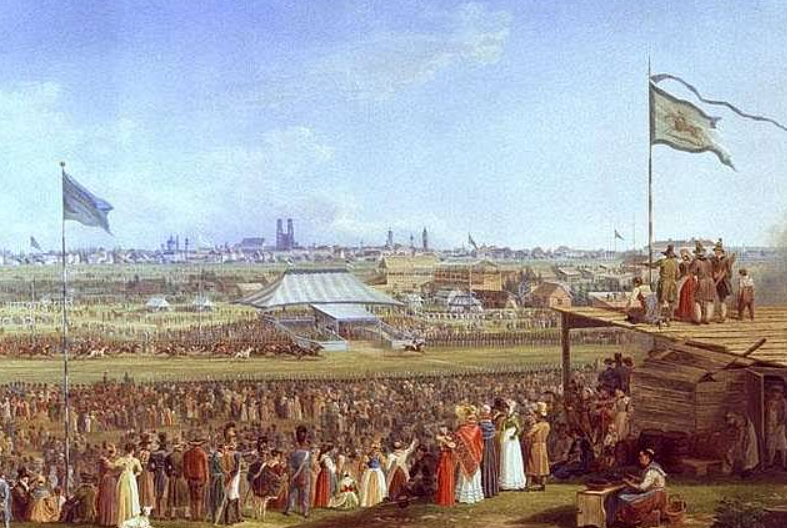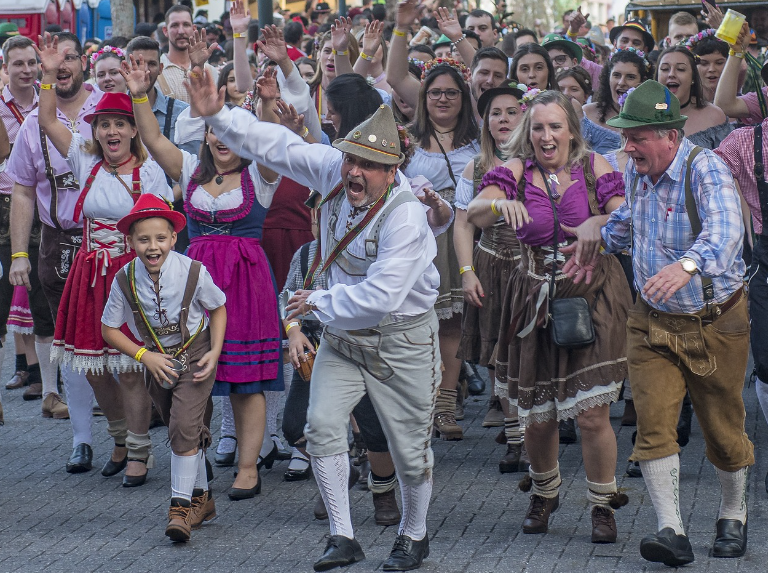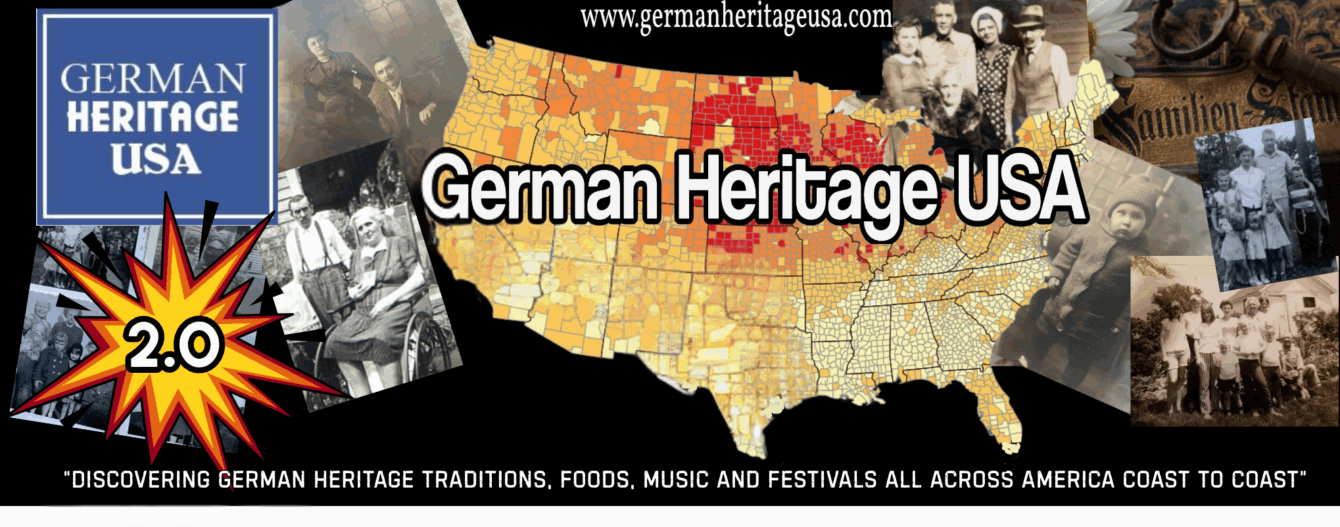The History of Oktoberfest: Royal Celebration & Heritage
GERMAN HERITAGE USA | AFFILIATE DISCLAIMER: This post may or may not contain affiliate links which means we may receive a commission for purchases made through links. We will only recommend products that we have personally used or that we truly trust. Learn more on our Private Policy and Disclaimer Page located under our Terms Of Service tab above.
Did you know Oktoberfest, the world’s biggest beer festival, draws six million visitors every year? This fact shows how much people love a tradition that started over two hundred years ago. It all began as a big celebration for a royal wedding.

A vibrant scene of Oktoberfest in Munich, featuring large, colorful beer tents filled with people in traditional Bavarian attire, lively festivities, an array of delicious German foods, tall mugs of beer being raised in cheer, a backdrop of historic architecture and fairground rides, all under a clear blue sky.
The idea of Oktoberfest as we know it today came from Andreas Michael Dall’Armi, a member of the Bavarian National Guard. He suggested a public celebration to King Max I Joseph. The first Oktoberfest lasted five days and included a horse race. Kids in traditional Bavarian outfits honored the royal couple.
Now, Oktoberfest is more than just a royal celebration. It’s a cultural event loved by many. Every year, millions visit Munich’s Theresienwiese to experience history, culture, and great beer.

Key Takeaways
- Oktoberfest began in 1810 as a royal wedding celebration
- The festival takes place on Munich’s Theresienwiese
- It attracts around six million visitors annually
- The event started with a horse race and children’s performances
- Oktoberfest has grown from a local celebration to a global phenomenon
The Royal Origins of Oktoberfest
Oktoberfest, the world’s largest volksfest, started with a royal wedding in Munich, Germany. It began over 200 years ago. It has grown into a cherished tradition.
Crown Prince Ludwig’s Wedding Celebration
In 1810, Crown Prince Ludwig married Princess Therese von Sachsen-Hildburghausen. The party lasted nearly a week, from October 12th to 17th. It was open to everyone in Munich, starting Oktoberfest.
The First Horse Race of 1810
On October 17th, a horse race kicked off the wedding party. It’s seen as Oktoberfest’s official start. The race was so loved that it kept happening every year, starting the festival tradition.
Birth of Theresienwiese Festival Grounds
The grounds were named “Theresens-Wiese” for Princess Therese. Now, locals call it “Wiesn” in Munich’s dialect. It’s where Oktoberfest is held, welcoming millions each year.
| Year | Milestone |
|---|---|
| 1810 | First Oktoberfest celebration |
| 1887 | Introduction of the Entry of the Oktoberfest Staff and Breweries parade |
| 1910 | 100th anniversary: 120,000 liters of beer served |
| 2005 | Introduction of “quiet Oktoberfest” concept |
Oktoberfest has grown from a royal event to a global celebration. Today, people wear lederhosen and dirndls. They enjoy traditional music, food, and beer.
The History of Oktoberfest: From Royal Wedding to Global Celebration
Oktoberfest started in 1810 as a royal wedding celebration. It has grown into a famous beer festival, showing off German culture. The first event was for the wedding of Crown Prince Ludwig and Princess Therese. It included a horse race and free food for everyone.
The first Oktoberfest was a hit, leading to it happening every year. By 1811, the Bavarian agricultural association took over organizing it. In 1819, the Munich city government made Oktoberfest a top event, setting it up for success.
Oktoberfest has grown a lot since its royal days. It now lasts two weeks, from mid-September to early October. This change helps visitors enjoy better weather.
- 6 million annual visitors
- 6 million liters of beer consumed
- 29 food and beer tents
- 12,000 people employed
Today, Oktoberfest is a big deal, showing off Bavarian traditions. It mixes old and new, giving a peek into German culture. From a royal wedding, Oktoberfest has become a worldwide event, attracting millions every year.
Evolution of Early Oktoberfest Traditions (1810-1850)
The Munich Theresienwiese saw big changes from 1810 to 1850. It went from a simple royal event to a big beer festival. Let’s look at the key moments that made Oktoberfest what it is today.
Agricultural Association’s Influence
The Bavarian Agricultural Association was key in shaping Oktoberfest. They brought in farming exhibits and competitions. These shows became a big part of the festival, drawing in farmers and fans.
Introduction of Entertainment at Oktoberfest
Beer stalls started appearing as the festival grew. This was the start of Oktoberfest’s link to beer. The first carousel and swing rides showed up in 1818. These added to the festival’s fun and lively vibe.

Lively scene of early Oktoberfest beer stalls, 1810s-1850s, wooden structures adorned with colorful bunting, traditional German motifs, people in historical Bavarian attire enjoying foamy beer steins, rustic tables filled with pretzels and sausages, vibrant autumn foliage in the background, festive atmosphere with sounds of laughter and music.
The festival grounds got better to handle more people. Organizers built temporary buildings, fixed paths, and added basic services. These changes helped create the Oktoberfest we love today.
| Year | Notable Additions |
|---|---|
| 1810 | First horse race and agricultural show |
| 1818 | Introduction of carousel and swings |
| 1850 | Establishment of large beer tents |
Oktoberfest’s growth from 1810 to 1850 laid the groundwork for its global fame. Mixing Bavarian traditions with new fun elements made a unique festival. It still draws millions every year.
The Rise of Beer Culture at Oktoberfest
Oktoberfest’s beer culture has grown from humble beginnings to become a global phenomenon. The festival’s focus on beer emerged in the late 19th century. It transformed the event into a celebration of Bavarian brewing traditions.
First Beer Tents and Their Evolution
In 1896, small beer stands were replaced by larger beer tents. This marked a significant shift in Oktoberfest’s character. These tents, backed by local Bavarian breweries, could serve thousands of visitors.
The Pschorr-Bräurosl tent, for example, could seat 12,000 people. It could also serve 12,000 hectoliters of beer.
Traditional Bavarian Breweries’ Involvement
Only beer brewed in Munich according to the Reinheitsgebot (German Purity Law) can be served at Oktoberfest. Breweries like Augustiner, Hofbräu, and Paulaner provide the festival’s signature lagers. These beers come in two main varieties: Marzen and Festbier.
Each offers unique flavors that capture the essence of Bavarian brewing traditions.
Birth of Beer Hall Culture
The expansion of beer tents gave rise to the iconic beer hall culture associated with Oktoberfest. These halls became hubs of entertainment, featuring oompah bands playing traditional Bavarian music. Today, waitresses in these halls showcase impressive strength.
They can carry up to 15 one-liter steins at a time. This beer-centric atmosphere has helped Oktoberfest grow into a celebration. It attracts over 6 million visitors annually, consuming more than 7 million liters of beer.
Cultural Significance and Traditional Elements
Oktoberfest is a key part of German culture, showing off Bavarian tradition. It started as a royal event and now draws millions every year.
The festival’s heart is the traditional brass bands. They play lively music that fills the air. People wear lederhosen and dirndls, showing their Bavarian roots. These outfits make the festival grounds a colorful sight.
The Wiesn-Einzug parade kicks off Oktoberfest. It features 8,000 people in traditional clothes, led by the Münchner Kindl. Munich’s six major breweries bring horse-drawn beer wagons, exciting everyone for the fun ahead.
Food and drink are big parts of Oktoberfest. People enjoy Bavarian treats like pretzels, sausages, and roast chicken. They also try Oktoberfest beer, made with a 1516 law that limits ingredients.
| Traditional Element | Description |
|---|---|
| Costumes | Lederhosen and dirndls |
| Music | Traditional brass bands |
| Parade | Wiesn-Einzug with 8,000 participants |
| Food | Pretzels, sausages, roast chicken |
| Beer | Brewed by Munich’s six major breweries |
Oktoberfest’s impact goes beyond its time. It influences celebrations globally and boosts Munich’s economy. It keeps Bavarian traditions alive, loved by many for years to come.
Expansion and Modernization (1850-1900)
The world’s largest volksfest grew a lot between 1850 and 1900. This time was full of growth and new ideas for Oktoberfest at Munich Theresienwiese. It turned from a small event into a big celebration, drawing people from everywhere.
Introduction of Electric Lighting
In the late 1800s, electric lights came to Oktoberfest. This big change made the festival grounds magical at night. The lights made the fun go on longer, into the evening.
Growth of Entertainment Options
The History of Oktoberfest: Royal Celebration & Heritage. Oktoberfest got more fun things to do during this time. New rides and shows were added for everyone. The festival was full of life, with rides and shows for all. This made Oktoberfest a top event to see.
Bavaria Statue Installation
In 1850, the Bavaria statue was shown at Munich Theresienwiese. This huge bronze figure became Oktoberfest’s symbol. Its arrival added a special touch to the festival.
| Year | Event | Impact |
|---|---|---|
| 1850 | Bavaria Statue Unveiled | Became a symbol of Oktoberfest |
| Late 1800s | Electric Lighting Introduced | Enhanced nighttime atmosphere |
| 1887 | First Oktoberfest Parade | Showcased breweries and traditions |
These changes made Oktoberfest the biggest volksfest in the world. It grew with society, using new tech but keeping its traditions.
Challenges Through Two World Wars
Oktoberfest, a key part of German culture, faced big challenges in the 20th century. It had to overcome two world wars and economic troubles. The festival showed great strength during these hard times.
World War I was the first big problem for Oktoberfest. It was canceled from 1914 to 1918 as Germany fought. After the war, Germany faced hyperinflation in 1923 and 1924. This forced Oktoberfest to stop again.
World War II brought Oktoberfest to a halt once more. The grounds, Theresienwiese, were empty as Munich struggled. Oktoberfest has been canceled 26 times, with the wars being a big reason.
“O’zapft is!” – The Mayor of Munich’s proclamation at the tapping of the first keg, a tradition since 1950.
But Oktoberfest never gave up. Its return after each war showed hope and the strength of Bavarian traditions. Now, Oktoberfest is a symbol of German culture’s resilience. It welcomes millions every year to celebrate its heritage.
Post-War Revival and Modern Era
After World War II, Oktoberfest began a new chapter. It became the world’s largest volksfest, mixing old traditions with new ideas. Beer tents got bigger, oompah bands played louder, and millions came to Munich every year.
Mayor’s First Keg Tapping Tradition
In 1950, Munich’s Mayor Thomas Wimmer started a tradition. He tapped the first beer keg, starting the fun. This tradition is now a big deal, with the Mayor trying to open the barrel with few strikes.
Introduction of “O’zapft is!” Ceremony
The “O’zapft is!” cry goes through the grounds when the first keg is tapped. Since 1980, the Bavarian Minister-President gets the first pint. This marks the start of 16 to 18 days of fun, with big beer tents and oompah bands.
Development of Modern Festival Layout
Oktoberfest grew, so did its layout. The grounds got bigger to fit millions of visitors. Now, there are over a dozen beer tents, each holding 10,000 people. The festival draws 5-7 million visitors, drinking millions of liters of Munich beer.
| Year | Milestone |
|---|---|
| 1950 | Mayor’s keg tapping tradition begins |
| 1980 | Bavarian Minister-President receives first pint |
| 2005 | Introduction of “quiet Oktoberfest” concept |
| 2010 | 200th anniversary celebration |
Contemporary Oktoberfest Experience
The History of Oktoberfest: Royal Celebration & Heritage. Today’s Oktoberfest is a mix of old traditions and new fun, attracting millions to Munich every year. The festival’s beer roots are seen in its huge tents, which can hold up to 10,000 people. These tents started in 1896, replacing the original stands from 1811.
Beer Tent Culture Today
Six German breweries have the special right to serve their beer at Oktoberfest. Visitors get to enjoy one-liter servings of Märzenbier or Oktoberfestbier. These beers have a rich malt flavor and 5-6% alcohol. This tradition has inspired American craft brewers to make their own fall seasonals.
City Brew Tours shows these German-inspired brews across the East Coast.
Traditional Costumes and Music
The festival’s vibe is boosted by people wearing lederhosen and dirndls, traditional Bavarian clothes. Oompah bands play lively tunes, adding to the fun. This mix of costumes and music takes visitors back to the event’s royal wedding roots in 1810.
Modern Safety and Management
With about 6 million visitors each year, Oktoberfest focuses on safety and being family-friendly. The 2005 “quiet Oktoberfest” rule limits music before 6 PM. These steps help the world’s biggest folk festival keep its heritage alive while meeting today’s needs.
FAQ
When and why did Oktoberfest originate?
Oktoberfest started in 1810 to celebrate Crown Prince Ludwig’s wedding to Princess Therese of Sachse-Hildburghausen. It kicked off with a horse race on October 17, 1810. The event was held on Theresienwiese, named after the bride.
Who proposed the idea for the first Oktoberfest?
Andreas Michael Dall’Armi, a member of the Bavarian National Guard, suggested Oktoberfest to King Max I Joseph. He was honored with Munich’s first gold citizens’ medal in 1824 for his role in creating Oktoberfest.
How did Oktoberfest evolve from a royal celebration to a public event?
Oktoberfest was held every year after the first celebration in 1810. The Bavarian agricultural association took over in 1811. By 1819, the Munich city government saw its potential for making money.
When were beer tents introduced to Oktoberfest?
Beer tents started as small stalls in the late 19th century. By 1910, the biggest tent could serve 12,000 hectoliters of beer and hold 12,000 people.
What traditional elements are associated with Oktoberfest?
Oktoberfest celebrates Bavarian culture with lederhosen, dirndls, and brass band music. It also features parades, starting with the Entry of the Oktoberfest Staff and Breweries in 1887.
How has Oktoberfest been affected by historical events?
The History of Oktoberfest: Royal Celebration & Heritage. Oktoberfest faced challenges during World Wars and economic crises. It was either cancelled or held as a smaller festival. But it returned to its full scale after World War II.
What is the “O’zapft is!” ceremony?
The “O’zapft is!” ceremony marks Oktoberfest’s start. Since 1950, Munich’s Mayor taps the first beer keg. Since 1980, the Bavarian Minister-President gets the first pint.
How many visitors does modern Oktoberfest attract?
Today, Oktoberfest welcomes around 6 million visitors each year, making it the world’s largest volksfest.
What is the “quiet Oktoberfest” concept?
Introduced in 2005, “quiet Oktoberfest” aims to be more family-friendly. It includes rules to keep music volume low before 6 PM.
Where does Oktoberfest take place?
Oktoberfest is held on Theresienwiese, a large area in Munich, Germany. It was named after Princess Therese, the bride of Crown Prince Ludwig.
Source Links
- The history of Oktoberfest – https://www.oktoberfest.de/en/magazine/tradition/the-history-of-oktoberfest
- The History Of Oktoberfest: From Royal Celebration To Global Phenomenon – https://aleaffair.com/what-is-the-history-of-oktoberfest/
- Oktoberfest History: Origins of the Festival – Oktoberfest – https://www.oktoberfesttours.com/oktoberfest/history-of-oktoberfest
- The Rich History of Oktoberfest: From Royal Wedding to Global Celebration – Shipgarten – https://shipgarten.com/the-rich-history-of-oktoberfest-from-royal-wedding-to-global-celebration/
- Why is Oktoberfest in September? | CIA Culinary School – https://www.ciachef.edu/blog/why-is-oktoberfest-in-september/
- Oktoberfest History: The first Oktoberfest in 1810 – https://oktoberfest-guide.com/magazine/the-first-oktoberfest-1810/
- Oktoberfest, The Biggest Folk Festival in World History — Beer is for Everyone – https://beerisforeveryone.com/oktoberfest-history/
- Germans on the Western Waters: Artisans, Material Culture, and Hybridity in Virginia’s Backcountry, 1780-1830. – https://www.academia.edu/12746369/Germans_on_the_Western_Waters_Artisans_Material_Culture_and_Hybridity_in_Virginias_Backcountry_1780_1830
- The History of Oktoberfest: A Celebration Beyond Beer – EZBREW – Automated Brewpub – https://ezbrew.beer/2023/09/the-history-of-oktoberfest-a-celebration-beyond-beer/
- The History of Oktoberfest – https://www.theepicureanbeers.co.uk/blogs/draft/oktoberfest?srsltid=AfmBOoqENEoiBlgABXBNCXvV8LiX0znRkQXWmbwTlLMThcNUv4401ZUk
- The Origins and Celebrations of Oktoberfest – https://socialstudieshelp.com/the-origins-and-celebrations-of-oktoberfest/
- The History of Oktoberfest: From Its Origins to Today | SchoolTube – https://www.schooltube.com/the-history-of-oktoberfest-from-its-origins-to-today/
- BOOK.indb – https://library.oapen.org/bitstream/20.500.12657/22822/1/9781138187337_text.pdf
- Regional Dress: Between Tradition and Modernity 9781350147980, 9781350148017, 9781350147997 – DOKUMEN.PUB – https://dokumen.pub/regional-dress-between-tradition-and-modernity-9781350147980-9781350148017-9781350147997.html
- Entertaining from Ancient Rome to the Super Bowl: An Encyclopedia – DOKUMEN.PUB – https://dokumen.pub/entertaining-from-ancient-rome-to-the-super-bowl-an-encyclopedia.html
- Oktoberfest – https://en.wikipedia.org/wiki/Oktoberfest
- Unveiling the Rich History of Oktoberfest: A Deeper Dive into the World’s Greatest German Festival – https://www.linkedin.com/pulse/unveiling-rich-history-oktoberfest-deeper
- History of Oktoberfest – https://www.dw.com/en/oktoberfest-turns-200-a-journey-through-its-history/a-5968160
- Oktoberfest History, Tradition & Fun Facts – https://oktoberfestwear.com/blogs/blog/oktoberfest-history-tradition-fun-facts
- Exploring Oktoberfest: The Heart of German Beer Festivals – https://confessionsofawinegeek.co.uk/exploring-oktoberfest-the-heart-of-german-beer-festivals
- Raising a stein to Oktoberfest – https://www.goodwood.com/editorial/raising-a-stein-to-oktoberfest/
- Oktoberfest: A Celebration of Beer, Culture, and Joy! – https://joyjolt.com/blogs/all_blogs/oktoberfest-a-celebration-of-beer-culture-and-joy?srsltid=AfmBOoqKT9aPQaog-EINBHYEvHKIes9gwfgRpFIXvaHc-FeX4GoH7OPT
- Oktoberfest and the Märzenbier – https://www.citybrewtours.com/blog/oktoberfest-and-the-marzenbier/
